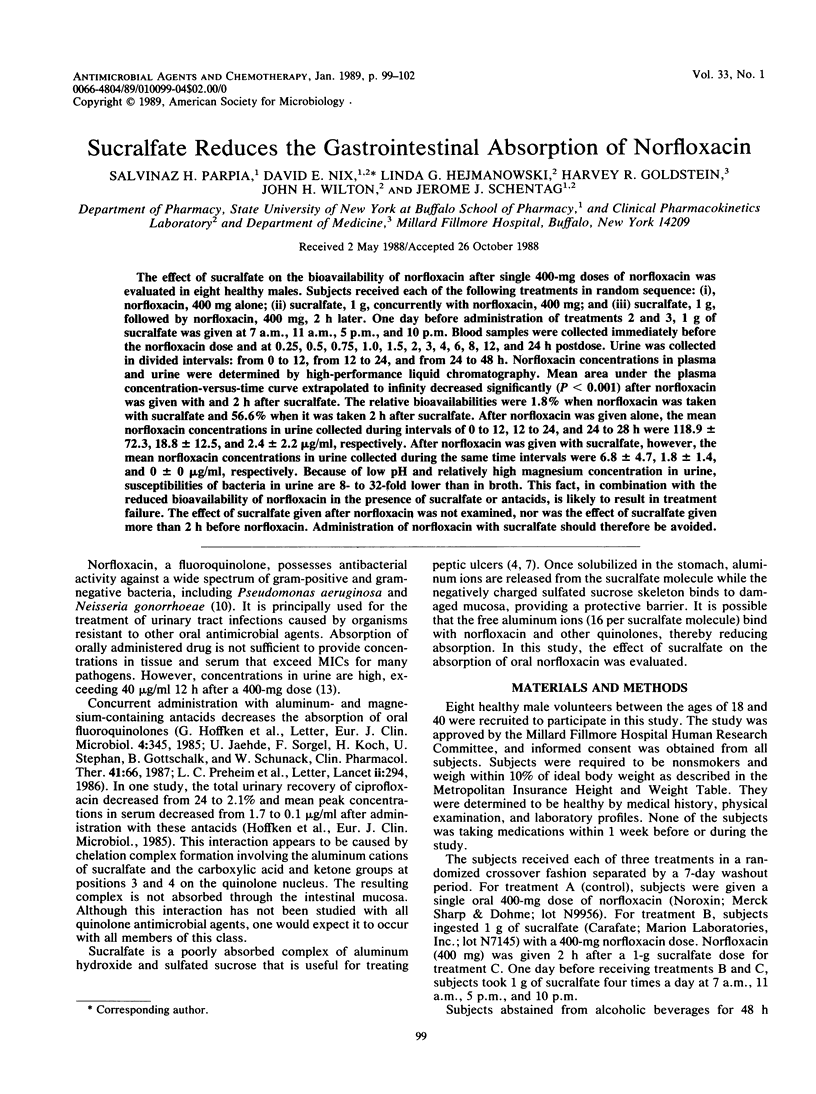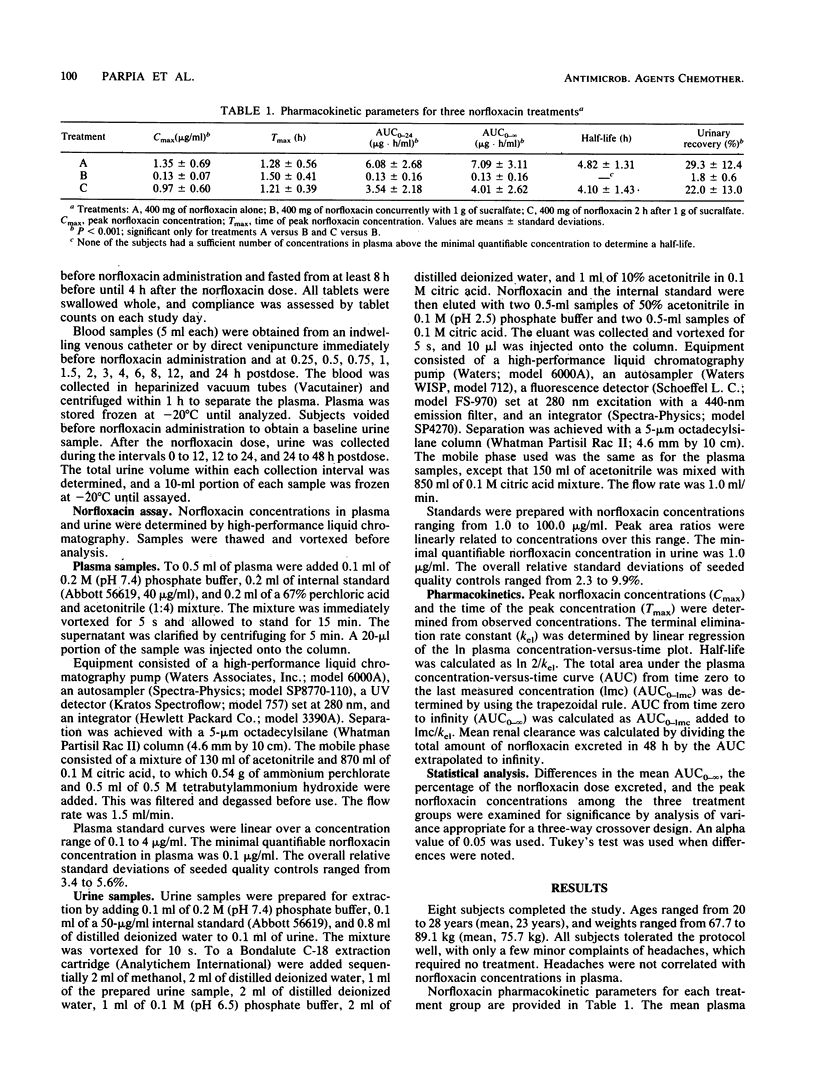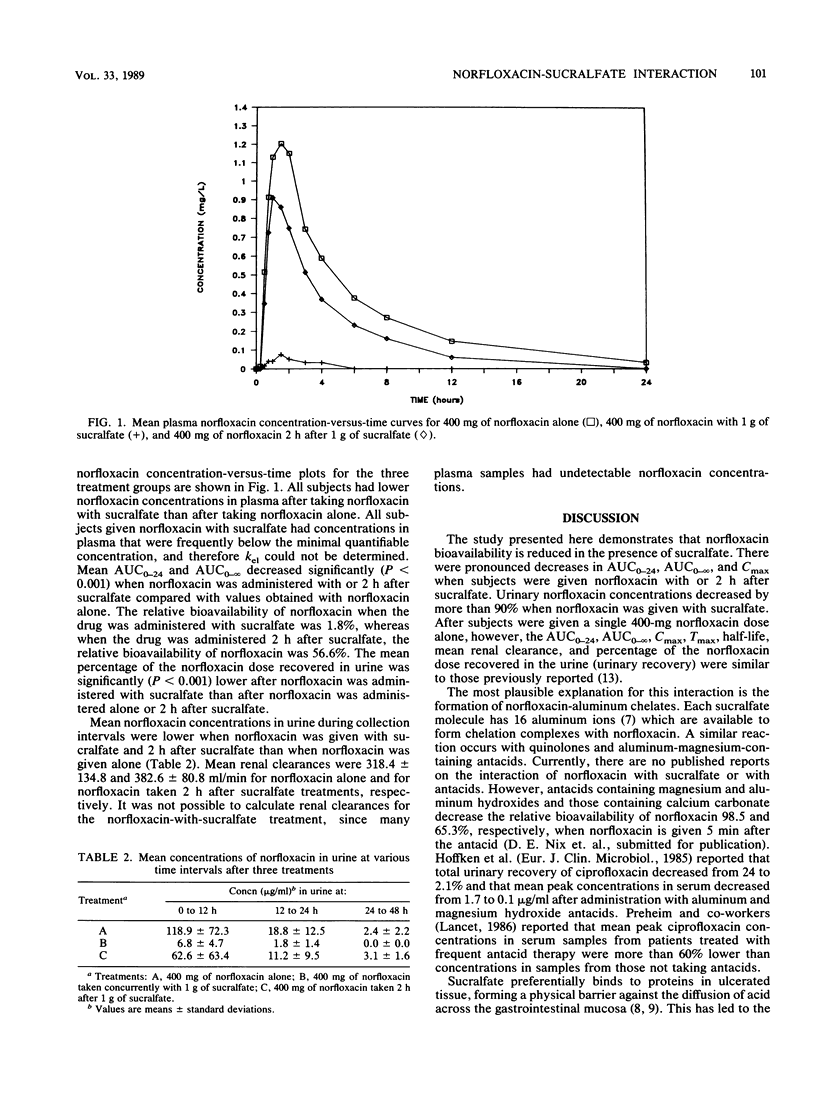Abstract
The effect of sucralfate on the bioavailability of norfloxacin after single 400-mg doses of norfloxacin was evaluated in eight healthy males. Subjects received each of the following treatments in random sequence: (i), norfloxacin, 400 mg alone; (ii) sucralfate, 1 g, concurrently with norfloxacin, 400 mg; and (iii) sucralfate, 1 g, followed by norfloxacin, 400 mg, 2 h later. One day before administration of treatments 2 and 3, 1 g of sucralfate was given at 7 a.m., 11 a.m., 5 p.m., and 10 p.m. Blood samples were collected immediately before the norfloxacin dose and at 0.25, 0.5, 0.75, 1.0, 1.5, 2, 3, 4, 6, 8, 12, and 24 h postdose. Urine was collected in divided intervals: from 0 to 12, from 12 to 24, and from 24 to 48 h. Norfloxacin concentrations in plasma and urine were determined by high-performance liquid chromatography. Mean area under the plasma concentration-versus-time curve extrapolated to infinity decreased significantly (P less than 0.001) after norfloxacin was given with and 2 h after sucralfate. The relative bioavailabilities were 1.8% when norfloxacin was taken with sucralfate and 56.6% when it was taken 2 h after sucralfate. After norfloxacin was given alone, the mean norfloxacin concentrations in urine collected during intervals of 0 to 12, 12 to 24, and 24 to 28 h were 118.9 +/- 72.3, 18.8 +/- 12.5, and 2.4 +/- 2.2 micrograms/ml, respectively. After norfloxacin was given with sucralfate, however, the mean norfloxacin concentrations in urine collected during the same time intervals were 6.8 +/- 4.7, 1.8 +/- 1.4, and 0 +/- 0 microgram/ml, respectively. Because of low pH and relatively high magnesium concentration in urine, susceptibilities of bacteria in urine are 8- to 32-fold lower than in broth. This fact, in combination with the reduced bioavailability of norfloxacin in the presence of sucralfate or antacids, is likely to result in treatment failure. The effect of sucralfate given after norfloxacin was not examined, nor was the effect of sucralfate given more than 2 h before norfloxacin. Administration or norfloxacin with sucralfate should therefore by avoided.
Full text
PDF



Selected References
These references are in PubMed. This may not be the complete list of references from this article.
- D'Angio R., Mayersohn M., Conrad K. A., Bliss M. Cimetidine absorption in humans during sucralfate coadministration. Br J Clin Pharmacol. 1986 May;21(5):515–520. doi: 10.1111/j.1365-2125.1986.tb02834.x. [DOI] [PMC free article] [PubMed] [Google Scholar]
- Gambertoglio J. G., Romac D. R., Yong C. L., Birnbaum J., Lizak P., Amend W. J., Jr Lack of effect of sucralfate on prednisone bioavailability. Am J Gastroenterol. 1987 Jan;82(1):42–45. [PubMed] [Google Scholar]
- Gesu G. P., Eftimiadi C., Debbia E., Schito G. C. Effects of changes in pH, medium and inoculum size on the in vitro activity of different quinolone and fluoroquinolone antibiotics against urinary pathogens. Drugs Exp Clin Res. 1987;13(2):79–84. [PubMed] [Google Scholar]
- Lau A. H., Chang C. W., Schlesinger P. K. Evaluation of a potential drug interaction between sucralfate and aspirin. Clin Pharmacol Ther. 1986 Feb;39(2):151–155. doi: 10.1038/clpt.1986.26. [DOI] [PubMed] [Google Scholar]
- Letendre P. W., Carlson J. D., Seifert R. D., Dietz A. J., Jr, Dimmit D. Effect of sucralfate on the absorption and pharmacokinetics of chlorpropamide. J Clin Pharmacol. 1986 Nov-Dec;26(8):622–625. doi: 10.1002/j.1552-4604.1986.tb02960.x. [DOI] [PubMed] [Google Scholar]
- Nagashima R. Development and characteristics of sucralfate. J Clin Gastroenterol. 1981;3(Suppl 2):103–110. [PubMed] [Google Scholar]
- Nagashima R., Yoshida N. Sucralfate, a basic aluminum salt of sucrose sulfate. I. Behaviors in gastroduodenal pH. Arzneimittelforschung. 1979;29(11):1668–1676. [PubMed] [Google Scholar]
- Nakazawa S., Nagashima R., Samloff I. M. Selective binding of sucralfate to gastric ulcer in man. Dig Dis Sci. 1981 Apr;26(4):297–300. doi: 10.1007/BF01308368. [DOI] [PubMed] [Google Scholar]
- Nix D. E., DeVito J. M. Ciprofloxacin and norfloxacin, two fluoroquinolone antimicrobials. Clin Pharm. 1987 Feb;6(2):105–117. [PubMed] [Google Scholar]
- Pugh M. C., Small R. E., Garnett W. R., Townsend R. J., Willis H. E. Effect of sucralfate on ibuprofen absorption in normal volunteers. Clin Pharm. 1984 Nov-Dec;3(6):630–633. [PubMed] [Google Scholar]
- Swanson B. N., Boppana V. K., Vlasses P. H., Rotmensch H. H., Ferguson R. K. Norfloxacin disposition after sequentially increasing oral doses. Antimicrob Agents Chemother. 1983 Feb;23(2):284–288. doi: 10.1128/aac.23.2.284. [DOI] [PMC free article] [PubMed] [Google Scholar]
- Zeiler H. J. Influence of pH and human urine on the antibacterial activity of ciprofloxacin, norfloxacin and ofloxacin. Drugs Exp Clin Res. 1985;11(5):335–338. [PubMed] [Google Scholar]


